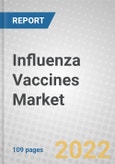The report explains critical trends in the influenza vaccine industry. It discusses the market determinants, which act as motivating or restraining factors, and provides insights to stakeholders and potential entrants. This report study includes only human vaccines; animal vaccines have not been considered in this report. This study looks at most of the systems affected by factors such as considerable research and development spending and increasing competition and new technologies, which are giving direction to the market. These advancements, new product launches and changing lifestyles are influencing future market growth. Company merger acquisition strategies and collaborations are also covered in this report. Additionally, this study discusses the strengths and weaknesses of each strategy type considering new technologies, growing competition and changing customer needs. The market has also been analyzed based on the type of influenza vaccines. Categories considered in this report include inactivated vaccines and live-attenuated vaccines. This study details market growth among vaccine manufacturers and end users. Genomic research centers, academic institutions, government and private laboratories and various hospital settings, as well as pharmaceutical, diagnostic and biotechnology companies and physicians, will find this study to be of interest. The report provides useful information to all market players, potential entrants, government agencies and other interested parties. As the report covers geographic regions in detail, companies interested in expanding their geographic reach will also find this study useful.
Report Includes
- 20 data tables and 29 additional tables
- An updated overview of the global market for influenza vaccines within the biopharmaceutical industry
- Analyses of the global market trends, with historic revenue (sales) data for 2019-2021, and projections of compound annual growth rates (CAGRs) through 2026
- Evaluation and forecast the market size for influenza vaccines, and corresponding market share analysis by type, technology, age, and region
- Information on baloxavir marboxil (Xofluza) vaccine, along with types of influenza virus strains used for vaccine preparation like influenza type A with H3N2 virus strain, influenza type A with H1N1 virus strain, and influenza type B virus strain
- Country specific data and market value analysis for the U.S., Canada, Germany, U.K., France, Italy, Spain, Australia, Japan, China and India
- Technology assessment of the key drivers, restraints and opportunities that will shape the market over the next five years (2021 to 2026)
- Discussion of technology advancements in influenza vaccines development, product innovations, government regulations, clinical trials, and other key market strategies
- Coverage of key merger acquisition strategies and collaboration agreements in the marketplace
- In-depth information on increasing investments on R&D activities, key technology issues, industry specific challenges, major types of end-user markets, and COVID-19 implications on the progress of this market
- Descriptive company profiles of the leading global players, including AstraZeneca, CSL Ltd., Abbott Laboratories, GlaxoSmithKline plc and Sanofi
Table of Contents
Chapter 1 Introduction
Chapter 3 Market and Technology Background
Chapter 4 Impact of Covid-19
Chapter 5 Influenza Vaccines Market Dynamics
Chapter 6 Market Breakdown by Type
Chapter 7 Market Breakdown by Technology
Chapter 8 Market Breakdown by Age
Chapter 9 Market Breakdown by Region
Chapter 10 Company Profiles
List of Tables
List of Figures
Executive Summary
The fast growth rate of the inactivated vaccines is attributed to increasing company investments in IIV development and the excellent stability profile of this vaccine type, which has a proven record of safety and immune response.The global influenza vaccines market is segmented in this report by type, technology, age and region.
Reasons for Doing This Study:
The World Health Organization estimates that seasonal influenza may result in 290,000 to 650,000 deaths annually due to respiratory diseases alone. There are several reasons to get the influenza (flu) vaccine each year. Flu vaccination is the best way to obtain protection against flu and possibly severe complications. Flu vaccinations avoid millions of instances of illness and flu-related doctor’s visits each year. For instance, during 2019-2020, flu vaccination averted a projected 7.5 million instances of influenza illnesses, 3.7 million influenza-related medical visits, 105,000 influenza-associated hospitalizations and 6,300 influenza-associated fatalities. Vaccination is one of the most cost-effective
ways to reduce the seasonal influenza disease load. The overall increase in infectious and noninfectious diseases, growing population, technological advancements and continuous innovations are creating a considerable scope for the influenza vaccines market. The resurgence of vaccine-preventable diseases and the emergence of new pandemics and immunization programs in emerging economies also influence the global influenza vaccines market. This report is designed to be a critical decision-making tool for the intended audience, including influenza vaccine manufacturing players, potential market entrants and other professionals involved with or interested in immunology and vaccine-preventable seasonal influenza.
Companies Mentioned
- Abbott Laboratories
- Astrazeneca plc
- Bharat Biotech International Ltd.
- Biodiem Ltd.
- Csl Ltd.
- Emergent Biosolutions Inc.
- Gc Biopharma (Green Cross Corp.)
- GlaxoSmithKline plc
- Novavax Inc.
- Sanofi
- Sinovac Biotech Ltd.
Table Information
| Report Attribute | Details |
|---|---|
| No. of Pages | 109 |
| Published | May 2022 |
| Forecast Period | 2021 - 2026 |
| Estimated Market Value ( USD | $ 6.9 Billion |
| Forecasted Market Value ( USD | $ 10.1 Billion |
| Compound Annual Growth Rate | 7.9% |
| Regions Covered | Global |
| No. of Companies Mentioned | 11 |









